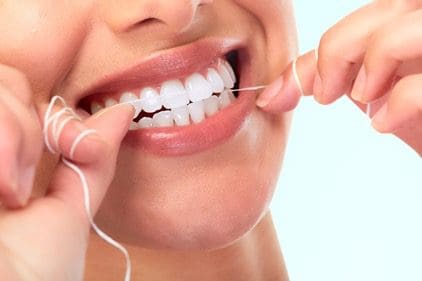At Parkview Dental Associates, we recommend flossing or cleaning with an interdental cleaner in addition to brushing daily. Cleaning between your teeth not only serves to dislodge trapped food debris, but it also removes a sticky film called plaque that contains bacteria which causes cavities and gum diseases. Over time, the plaque buildup can harden into a rough substance called tartar (or calculus). Once tartar forms, the only way to remove it is with the help of a dental professional. Tartar can cause bad breath, tooth decay, and periodontitis if left untreated. Some patients stop flossing when they experience sensitive or bleeding gums. In fact, bleeding gums is one of the first signs of early-stage gum disease known as gingivitis. Though gingivitis is reversible, late-stage gum disease (periodontitis) is not.
There are a myriad of choices on the market today to make flossing easier and more efficient. Besides traditional string floss, there are many other alternatives to choose from depending on your lifestyle, personal preference, manual dexterity, spaces between your teeth and whether you have orthodontic appliances.
Waxed floss has a coating that makes it easier to thread the floss between tight spaces. The waxed layer also helps to prevent the floss from shredding or breaking during use.
Unwaxed floss is made up of multiple nylon strands twisted together. It has no coating or flavor; therefore, is free from chemicals. It might be a good choice for those who don’t like the residual taste left by waxed floss or expectant mothers who want an unflavored floss that won’t trigger nausea. Since it is much thinner than other types of floss, however, it is more prone to shred and break.
Super Floss is specially designed for users who have bridges, braces, and wide teeth gaps. It has three parts: a stiff end threader, a regular floss portion, and a spongy floss portion. The threader helps to maneuver the floss under bridges and braces for better cleaning. The spongy part of the floss helps to clean between wider spaces, and the regular floss helps to clean under the gum line.
A dental pick (aka floss on a stick) has a floss attached to the “Y” shaped floss holder. It is very effective in accessing hard-to-reach areas of the mouth and particularly helpful to those with limited manual dexterities. However, since the floss is fixed at two ends, it cannot be curved into the recommended “C” shape to clean around the base of the tooth and below the gum line.
Proxy brushes (Interdental or interproximal brushes) have either Christmas tree-shaped or straight tip (pipe cleaners). When used properly, these brushes are very effective in reducing gum bleeding and removing plaque between your teeth especially when the gaps between the teeth are large. Proxy brushes come in various shapes and sizes. When choosing the correct size for your teeth, look for the largest brush that can get in between your teeth without the wire touching your teeth. When brushing, make sure the brush goes all the way through. You can bend the brushes (only bend the rubber part, not the wire part) to access hard-to-reach areas.
Gum Soft-picks Advanced have soft, flexible tips. They not only clean the spaces between the teeth, but they also massage and stimulate the gums to promote gum health. When cleaning with a soft-pick, make sure you insert the pick all the way through between the teeth.
A water flosser can help lower the risk of gum disease and dental cavities by flushing out food and other harmful bacteria around the tooth and below the gumline. Water flossers are particularly beneficial if you have inflamed and bleeding gums, periodontal pockets, a permanent retainer, braces, a lingual bar, diabetes, an implant, or a bridge. We also recommend water flossers to patients undergoing periodontal treatments such as scaling and root planing (deep cleaning). Start with low water pressure and work your way up to higher water pressure. Direct the nozzle along the gum line (where the teeth and gum meet) and make sure to clean both inside and outside of the gum line. It is important to keep in mind, however, that water flossing should not be considered a substitute for brushing and thread flossing because it doesn’t remove visible film and plaque on and between your teeth. Regular flossing is most effective for cleaning between tight spaces because you can scrape up and down the sides of the teeth. We recommend using a water flosser prior to brushing as removing food debris can enhance the effectiveness of toothpaste and brushing.
To summarize, brushing alone doesn’t remove the plaque in between your teeth and along your gum line which can lead to bad breath, cavities, tooth loss and gum diseases. Chronic oral health problems are associated with other health problems such as diabetes, Alzheime’s and heart diseases. Your best flossing method is whichever you are motivated to use daily! Experiment and choose based on what makes it easiest and most comfortable for you to use.

